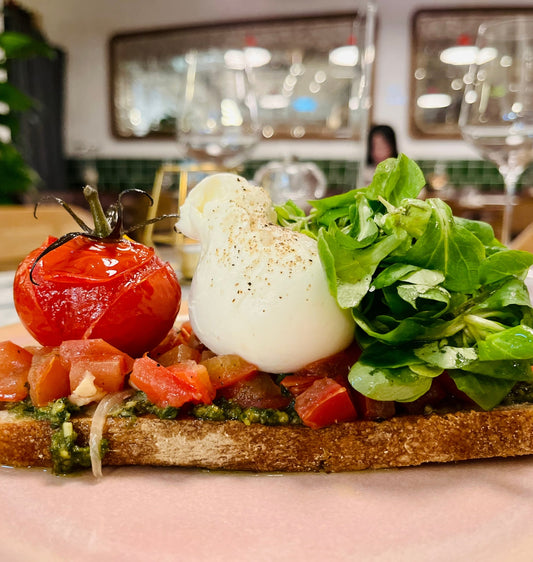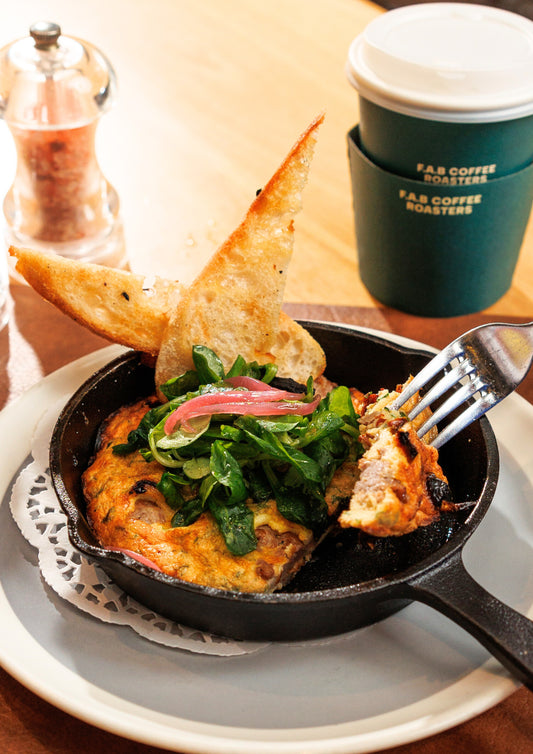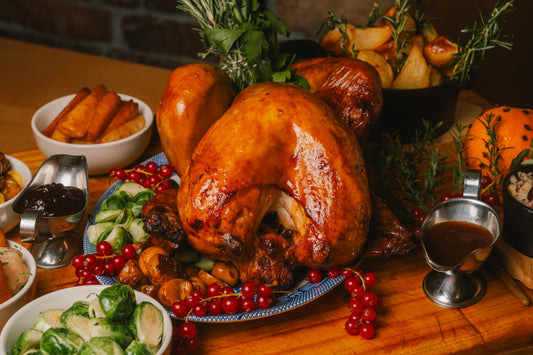
烤羊排食譜
想要烤出鮮嫩多汁的羊排,首先要選用 Feather & Bone 最好的食材,然後按照我們廚師的詳細步驟進行操作,保證成功。
如果你想用最少的精力打造令人驚豔的用餐體驗,那就一定要試試烤肉。將一大塊肉調味或醃製,放進烤箱,然後就可以和你的客人一起喝點東西,看著這塊肉慢慢烤至完美。烤肉的步驟幾乎沒什麼變數,只要掌握好幾個重點,就能保證成功。如果你選用上等的肉,並以適當的溫度和時間烤製,那就絕對不會出錯。當然,我們的食譜會為你詳細講解所有細節。
鮮嫩的羊排不宜超過三分熟。由於羊排是下腹部的部位,結締組織和強韌的肌肉纖維含量極少,無需長時間烹調即可,因此烹調時間短是最佳選擇。只需在熱鍋中快速煎一下即可,最好使用厚底鍋,先從肥肉麵開始煎(記得請肉舖老闆保留一些肥肉),然後翻面煎至四面金黃酥脆。之後放入預熱至180°C的烤箱中烤15分鐘(確保烤箱已預熱),即可獲得鮮嫩多汁的羊排,切開後即可輕鬆享用。
您可以在我們的羊肉分割大師班中了解羊肉的不同部位和屠宰過程。
既然說到褐變,那就讓我們這些美食愛好者來聊聊美拉德反應吧。這是一種烹飪化學原理,指的是強烈的直接加熱能使肉類中的天然糖分焦糖化,從而賦予肉類烘烤後的焦香和鮮美風味,帶來極致的肉食體驗。無論你是用煎鍋或燒烤架煎牛排,還是在長時間燉煮前先將燉肉表面煎至金黃,又或者像我們這裡提到的——在烤箱烘烤前先給肉塊表面形成一層“焦殼”,美拉德反應都值得你多花點心思。
完美的烤羊排需要四個步驟:醃製、煎烤、烘烤和靜置。現在,就讓我們這些肉食愛好者(或者說,我們這些對肉充滿熱情的廚師)來一步步指導您,保證您能做出一頓萬無一失的烤羊排大餐。
烤羊排-食譜
原料
2 份 700 克羊排 – 法式去骨,附脂肪層
4瓣大蒜-切碎
半包(10克)迷迭香-摘下葉子並切碎
60毫升特級初榨橄欖油-用於醃製
40毫升橄欖油-用於煎烤
用四指捏起一小撮海鹽片
適量黑胡椒
方法
準備醃料
製作醃料時,將大蒜、迷迭香、鹽、胡椒和特級初榨橄欖油混合。嚐一口-蒜味應該很濃,但不能過重,鹹味要足,並帶有明顯的迷迭香草本香氣。如果需要,可以再加鹽、胡椒或橄欖油。記住,醃料的味道要濃鬱一些,因為之後會稀釋在兩塊羊排上。
如果肉上還殘留脂肪,用鋒利的刀或美工刀,以大約1公分的間距,斜切出十字交叉的紋路。注意只切到脂肪,不要切到肉。
將醃料塗抹在烤架上,確保肉的每一面都塗抹到,不用擔心骨頭;就讓它們露在外面就行了。
放入冰箱醃製
將羊肉放入密封袋中,擠出多餘空氣——這有助於醃料更好地附著在肉上,然後放入冰箱冷藏。醃製2小時到2天都可以,時間越長,醃料的味道越濃鬱。
恢復至室溫
晚餐前兩小時將羊肉從冰箱取出,因為它需要完全恢復到室溫。這是至關重要的一步。如果羊肉中心在放入烤箱時仍然冰冷,就沒有足夠的時間充分烤熟,導致中間幾塊肉片夾生,或者兩邊烤過頭。
預熱烤箱並烘烤
將烤架豎起來,使肥肉/骨頭的一面朝上(你可以將兩個烤架交錯放置,使它們豎立起來),這樣頂部的脂肪在烹飪過程中就會融化到肉裡,使肉更濕潤,並增添更多風味。
將烤箱預熱至攝氏180度。晚餐前30分鐘,將烤架放入烤箱烤15分鐘,然後將肉類溫度計插入其中一排烤架的中間深處-溫度應在攝氏57度左右。如果低於此溫度,則將烤架放回烤箱再烤5分鐘左右,然後重新測試。
休息
將烤架從烤箱中取出,用錫箔紙鬆鬆地蓋住(這叫做“搭帳篷”,用錫箔紙搭成一個小帳篷),靜置 10 分鐘。
將烤架端上桌,配上鋒利的切肉刀。欣然接受大家的掌聲,然後將烤架切成小塊即可享用。



